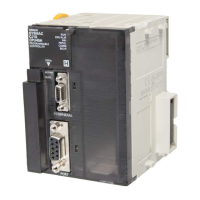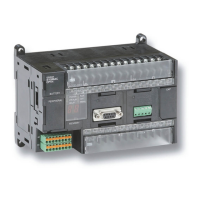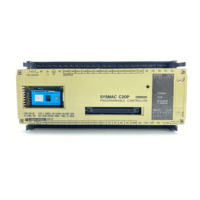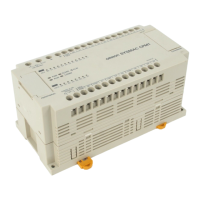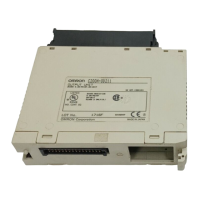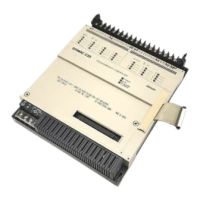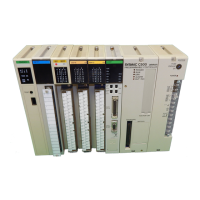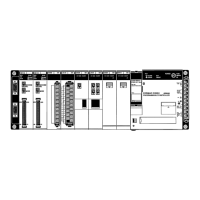7-7SectionAnalog Outputs
105
7-7 Analog Outputs
7-7-1 Applicable Models
Model numbers Functions
CS1W-HCA22 12 contact inputs, 8 contact outputs, 2 pulse inputs, 2 analog outputs
7-7-2 Outline
The CS1W-HCA22 Customizable Counter Unit provides 2 analog outputs. The
analog outputs can be set to –10 to 10 V, 0 to 10 V, 0 to 5 V, or 1 to 5 V. There is a
separate setting for each output.
Normally, the analog values stored in AR 14 and AR 15 are output cyclically on
the END refresh, but the outputs values can also be refreshed using the SPED
instructions for step-wise output or the ACC instruction for slopped output.
7-7-3 Specifications
Analog Outputs
Item Specification
Output signals Voltage outputs
Number of analog outputs 2 outputs
Output signal ranges One of the following set in the Unit Setup Area (port 1: DM 6613, port 2: DM 6614)
–10 to 10 V, 0 to 10 V, 0 to 5 V, or 1 to 5 V
D/A conversion time 0.5 ms max.
Resolution –10 to 10 V: 1/10,000 (14-bit value stored between EC78 and 1388 Hex)
0 to 10 V, 0 to 5 V, or 1 to 5 V: 1/4,000 (12-bit value stored between 0000 and
0FA0 Hex)
Analog output refresh method
Refreshing of analog outputs is set in the Unit Setup Area (DM 6630 bits 00 to 07
for both ports) to one of the following:
END refresh
Immediate refresh via SPED or ACC execution
END refresh If the Analog Output Conversion Enable Bit is ON (port 1:
AR 1600, port 2: AR 1601), the value in AR 14 or AR 15 is
output after program execution.
Immediate
refresh via
instructions
If the Analog Output Conversion Enable Bit is ON, the specified
analog value is output when the instruction is executed in the
program.
SPED: Analog output varied stepwise
ACC: Analog output with up or down slop (every 2 ms)
Note 1: Analog output values can also be controlled from
interrupt subroutines.
Note 2: The value of the analog outputs from startup until an
instruction controlling the analog output is executed will be as
set for the analog output hold function.
Analog output values For END refresh, the values in AR 14 and AR 15 are output.
For immediate refresh via instructions, the following values are output according to
the operands of the instruction.
–10 to 10 V: EC78 to 1388 Hex (–5,000 to 5,000 decimal) (resolution: 10,000)
corresponding to 0% to 100% voltage (–10 to 10 V) (Actually, the setting range is
EA84 to 157C (–5,500 to 5,500 decimal) corresponding to –5% to 105% voltage
(–11 to 11 V)
0 to 10 V, 0 to 5 V, or 1 to 5 V: 0000 to 0FA0 Hex (0000 to 4,000 decimal)
(resolution: 4,000) corresponding to 0% to 100% of the FS range. (Actually, the
setting range is FF38 to 1068 (–200 to 4,200 decimal) corresponding to –5% to
105% voltage (–0.5 to 10.5 V, –0.25 to 5.25 V, or 0.8 to 5.2 V)

